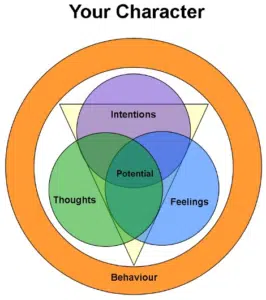Testing character in a difficult situation.
Good relationships built on trust (an outcome of good character) are critical to success – including success in the workplace.
There are many moments and situations which will test your character. Here is one example of a situation which can be challenging to navigate.
Situation.
How many times have you been pulled into a discussion with someone who is trying to represent someone else? That “third” person might have good intentions or they might just enjoy the drama of being in the middle of a potentially volatile situation. Or it might be pure manipulation.
It might sound like this, “J.D. has some feedback for you, but they would rather me explain it to you. They feel you get too defensive,” says Pat, one of your team members.
The question is how you do the right thing from a good character perspective?
The theme of ensuring your information is accurate applies here as well.
As soon as you hear someone talking about the thoughts and feelings of another, recognize a red flag.
This is secondhand information and we all know this can be dangerous territory.
What to do? Let’s tackle this situation from a character perspective.
Everyone possesses their own character. “Who you are” is displayed through your words and actions. But what drives your words and actions? How do you manage your character in this situation?
The graphic above identifies the internal and external elements that form our character and provides a self-management tool. (This model was explained more fully in our September blog).
So, in the example of someone attempting to manage your relationship with someone else, the first step is to take a breath and decide to respond thoughtfully, rather than reacting.
Potential Intention Questions,
· What would be the very best way for you to handle this situation?
· What outcome would you like to see?
· Do you want to get into this discussion with this person or are you better off speaking directly with the person in question?
Some potential “Thoughts” questions,
· What do you actually know about this situation?
· Where did the information come from?
· Is it possible that J.D. didn’t ask this person to speak on their behalf?
· Is it possible that J.D. doesn’t think this way at all?
· What else can you do to get clarity?
Possible “Feelings” questions,
· What emotion did you experience upon hearing about the situation?
· What emotion do you have to pay attention to as you go forward?
· What is the potential emotional state of the person who provided the information?
· What is the possible situation with the person being represented?
A few “Behaviour” questions,
· Given the “inner work” that you have done in order to deal with this situation, what will you actually do?
· What skill(s) do you require?
· How will you follow up with the person who provided the information?
Putting it Into Words (Behaviours)
Suggestion for what you could say to Pat.
· Thank you for bringing this issue to my attention. Please ask J.D. to speak to me directly.
Suggestions for what you can say to J.D.
· J.D. let’s talk about how you can help me be even more effective. I would appreciate hearing what you think I am doing well and what I could do better.
It may seem like a great deal of work to really honour your character, but this internal process can take place quite quickly. This is a tool for keeping your relationships as healthy as possible and minimizing the opportunity for unnecessary and time consuming drama.
Have a terrific month.
Kathleen Redmond MA, MCC
kr@centreforcharacterleadership.com
905.478.7962
Visit our website
Centre for Character Leadership | 1111 Davis Drive, 1-174, Newmarket, L3Y 7V1 Canada
Unsubscribe kareneaddison@gmail.com
Update Profile | Constant Contact Data Notice
Sent by kr@centreforcharacterleadership.com

